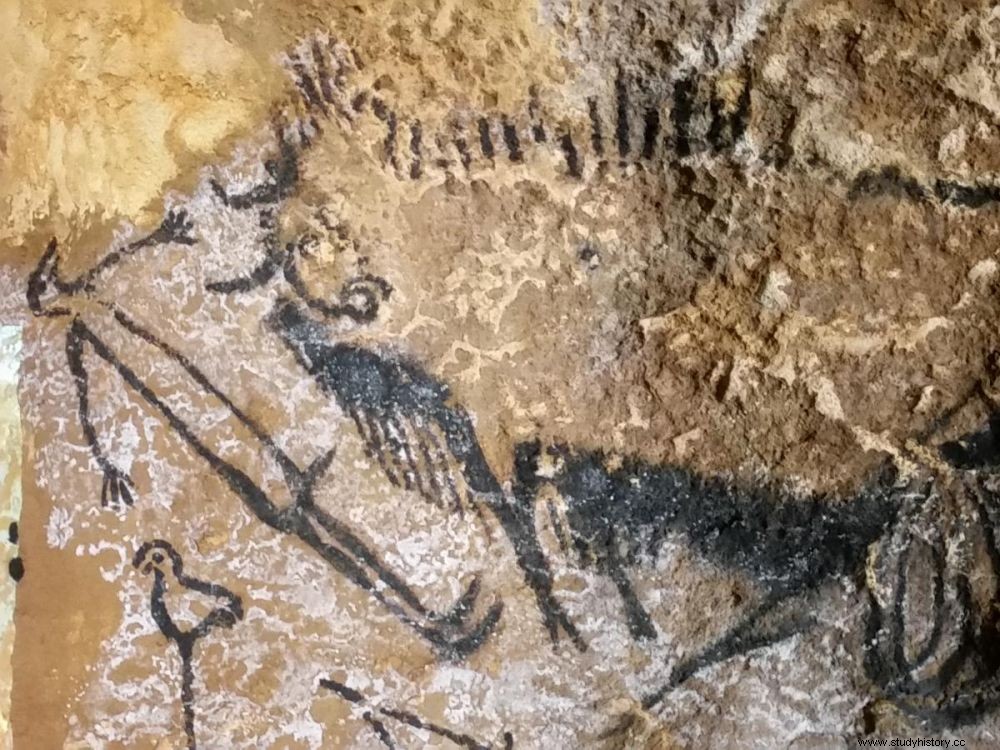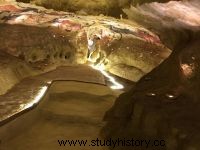On September 12, 1940, exactly 81 years ago, four friends aged 13 to 18 "explored a hole" on a hill in the Dordogne, and discovered there one of the treasures of humanity:the famous cave of Lascaux! On this occasion, we invite you to (re)read the article published in Sciences et Avenir 838 dedicated to the last facsimile of the prehistoric site, Lascaux IV.

Facsimile of the only human representation of the Lascaux cave.
UPDATE. On September 12, 1940, exactly 81 years ago, the adventure of four teenagers led to the discovery of one of the treasures of humanity:the famous cave of Lascaux. The last of these 4 buddies aged 13 to 18, Simon Coencas, died on February 2, 2020 at the age of 93. With Marcel Ravidat, Georges Agniel and Jacques Marsal, he had discovered the Lascaux cave by "exploring a hole" on a hill overlooking the village of Montignac, in the Dordogne. If the site is now inaccessible to the public, a modern version, a perfect facsimile of the cave, was inaugurated in 2016. We invite you to find the article by our journalist Bernadette Arnaud, great reporter at Sciences et Avenir , originally published in issue 838 of our magazine.
It is a hill that makes the round back. A pleasant green promontory barely 215 m above sea level, whose relief stretches for two kilometers along the left bank of the Vézère (Dordogne). Topped with thickets of chestnut trees and large pines, it emanates from it the sweet scents of chanterelle mushrooms. However, this hill is nothing ordinary. Its limestone entrails - karstic formations shaped millions of years ago - indeed conceal one of the treasures of humanity:the famous cave of Lascaux.
A "Sistine Chapel" dating back 17 thousand years, where the Paleolithic occupants caused herds of aurochs, ibexes, bison, deer and horses to run over the rock, in immemorial cavalcades of ocher and manganese. . That is 600 paintings, 400 geometric signs and 1500 engravings! In December 2016, the site experienced a particular turmoil. A new facsimile of the famous paintings - the third! - destination for tourists from all over the world has opened its doors. Objective:to further relieve the hill of too many people who still threaten the original cave - closed to the public in 1963 - despite the opening in 1983 of a first replica, Lascaux II, located... barely 200 meters away.
Serious hazards almost damaged the cave paintings at Lascaux
Because the experts have realized that the facilities necessary to welcome the 270,000 annual visitors to Lascaux II have in turn weakened the site, which is listed as a World Heritage Site. It was urgent and imperative to further divert the flow:Lascaux IV was therefore built on the edge of the small Périgord town of Montignac to confine cars, coaches and visitors as far as possible. The hill is indeed now "sanctuarized".
A decision that owes a lot to the creation in 2010 of the Scientific Committee of the Lascaux cave, led by Yves Coppens, the specialist in human evolution (and which he talks about below in the video shot by Sciences et Avenir ). To understand the stakes, it is indeed necessary to recall the serious hazards which, at the dawn of the 2000s, almost permanently altered the parietal paintings with the appearance on the walls of the cave of a virulent fungal and microbial proliferation.
White mold (Fursarium solani ), associated with the bacterium Pseudomonas fluorescens , then invaded the entrance hall, then the galleries. Worse! no treatment having come to the end of moulds, black ascomycete fungi (Ochroconis lascauxensis ) in turn appeared in 2006. The scientific community thought it was reliving a nightmare:that of the attack on the walls by green algae generated by the carbon dioxide released by visitors, which had led to the closure of the cave in 1963. The American weekly Time then raised the threat of a possible inscription of the cave of Lascaux on the list of the heritage sites in danger of Unesco!
A scientific committee coordinates the studies
An electric shock that led to the creation of the Scientific Committee. From then on, the change was total. There is no longer any question for Yves Coppens, in collaboration with the curator Murielle Mauriac, of considering the cave as an isolate:it is now the hill as a whole, and the whole of its ecosystem, that must be studied in association with archaeologists, geologists, microbiologists, hydrogeologists, soil scientists and climatologists specializing in underground environments. “We finally had to get out of the cave to understand what is going on there! Study the hill, the land, the water and the vegetation that covers it “says Yves Coppens. Result:since 2013, the programs follow one another, such as the one headed by Laurent Bruxelles, geomorphologist from Inrap, attached to the Toulouse Trace Laboratory (CNRS), who coordinates the geological study of the hill (read his portrait in S. and A. n° 835, September 2016 ).
For the anniversary of Lascaux, a visit to the International Center for Parietal ArtAnd the first results were not long in coming. “We were able to elucidate how water continued to seep into the cavity. For years, research had focused on the vertical of the cave, but it was the lateral penetrations that also had to be understood », explains the geologist. They are the ones that continue to "feed" the parasitic micro-organisms on the walls by bringing organic matter and chemical elements from the surface. Laurent Bruxelles and his team also highlighted the devastating role played by the various developments created since the discovery of the cave. "In less than a century, the cave and its environment have been more unbalanced than in 17,000 years before “, he laments. Thus huge cavities were dug in the 1950s by Roger Constant in an attempt to find the real entrance to Lascaux.
For years, this inhabitant of the hill removed hundreds of tons of sediment made up of the disaggregated sand of the Cretaceous limestones, exposing the site partially bare. "Paradoxically, these works serve us today as a model for understanding the composition of the karstic massif and the way the cavity functioned, continues Laurent Bruxelles. The Lascaux cave is in fact a sort of limestone island surrounded by pockets of sand. When these are filled with surface water, they swell like sponges and eventually flow into the cavity. »
Above, a report by Valentine Delattre shot in 2019 on the occasion of the first "Voyage du savoir" organized in Lascaux by Sciences et Avenir, and sponsored by Yves Coppens
Similarly, water flows have been accelerated by the degradation of the land above the cave due to agricultural activities. At the beginning of the XX th century, the thickness of the ground between the surface of the hill and the roof of the cavity was thus 1.20 m... of which only a thin layer of clay remains today. A situation that has not been improved by the noria of thousands of coaches dropping off tourists in front of the Lascaux II replica, the vibrations being felt in depth.
For the scientists, the objective is now to weaken all these water inflows, which are constantly measured by a battery of instruments within the cave itself. In addition to the construction of Lascaux IV, drastic measures were taken such as the drying up of the neighboring ponds as well as the closure to car traffic of the Regourdou road, which passed less than 10 meters from the cave and whose digging had -even contributed to destabilize the site.
"Recommendations have also been issued concerning the management of surface forests “, continues Laurent Bruxelles, too many old trees threatening to fall, which would scratch a little more the thin film of remaining clay. Likewise, the mechanical machines have been replaced… by horses to avoid creating ruts in which the water rushes to finish its course in the cave.
A new phenomenon for the moment without danger
Alongside these studies, a second research program is underway. It concerns a new and enigmatic phenomenon called “vermiculations”. Strange “staple” formations have indeed been found by the thousands on certain walls of Lascaux, forming sorts of composite aggregates mixing minerals and organic matter. "It is a phenomenon that seems to depend on both physico-chemical and microbiological factors, explains Pierre-Yves Jeannin, director of the Swiss Institute of Speleology and Karstology (ISSKA), in charge of this study. We do not know clearly the causes or the conditions in which they are formed. The specialist, however, wants to be reassuring:“There is no particular danger at the moment in Lascaux, none having reached the works. It is just necessary to take measures to prevent possible developments. »
For the time being, these phenomena are being studied inside nearby caves with no parietal work and located in the same geological levels, as well as in that of Rouffignac. Lascaux is visited every week by two agents in charge of its surveillance, the only ones authorized to enter the prehistoric sanctuary where, for the time being, the black spots seem to have stopped progressing.
HERITAGE
Lascaux IV, the new facsimile Total immersion guaranteed! Since December 15, 2016, Lascaux IV, the new International Center for Parietal Art, has opened its doors on the edge of the small Périgord town of Montignac. There, in an elegant semi-buried white building, is now presented all the masterpieces of the Magdalenian hunters. A fundamental difference compared to Lascaux II, the first copy inaugurated in 1983, which reproduced only the Hall of the Bulls and a gallery called “axial diverticulum”; and compared to Lascaux III, the itinerant and “kit” version of the decorated cave. The 575 m
2
of paintings and engravings from Lascaux IV have been reproduced strictly identically by the Atelier des facsimilés du Périgord (AFSP).
This clone was reconstructed in an underground world, where the lighting conditions of 20,000 years ago and the smell of stones were also simulated. A technological and scientific challenge of more than 57 million euros carried mainly by the New Aquitaine region, the General Council of the Dordogne, and the European Union, for this exceptional site of 8800 m
2
in total. Because Lascaux IV will include other areas including four additional rooms which will allow visitors, through the use of interactive equipment, to complete their knowledge. Virtual tours of other inaccessible decorated caves such as Cussac, in the Dordogne, or Cosquer, the underwater cavity located in the creeks near Marseille, will also be possible. As well as artistic confrontations between works from prehistory and contemporary artists in exhibition halls. For its part, Lascaux II will not be closed. Relieved of the excessive number of visitors, it should still welcome a few groups.



